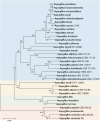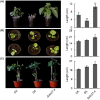New application of Aspergillus versicolor in promoting plant growth after suppressing sterigmatocystin production via genome mining and engineering
- PMID: 36415948
- PMCID: PMC9803325
- DOI: 10.1111/1751-7915.14176
New application of Aspergillus versicolor in promoting plant growth after suppressing sterigmatocystin production via genome mining and engineering
Abstract
Aspergillus genus is a key component in fermentation and food processing. However, sterigmatocystin (STE)-a mycotoxin produced by several species of Aspergillus-limits the use of some Aspergillus species (such as Aspergillus versicolor, Aspergillus inflatus, and Aspergillus parasiticus) because of its toxicity and carcinogenicity. Here, we engineered an STE-free Aspergillus versicolor strain based on genome mining techniques. We sequenced and assembled the Aspergillus versicolor D5 genome (34.52 Mb), in which we identified 16 scaffolds and 54 biosynthetic gene clusters (BGCs). We silenced cytochrome P450 coding genes STC17 and STC27 by insertional inactivation. The production of STE in the Δstc17 mutant strain was increased by 282% but no STE was detected in the Δstc27 mutant. Metabolites of Δstc27 mutant exhibited growth-promoting effect on plants. Our study makes significant progress in improving the application of some Aspergillus strains by restricting their production of toxic and carcinogenic compounds.
© 2022 The Authors. Microbial Biotechnology published by Applied Microbiology International and John Wiley & Sons Ltd.
Conflict of interest statement
The authors declare no conflict of interest.
Figures




Similar articles
-
Disruption of stcA blocks sterigmatocystin biosynthesis and improves echinocandin B production in Aspergillus delacroxii.World J Microbiol Biotechnol. 2019 Jul 6;35(7):109. doi: 10.1007/s11274-019-2687-9. World J Microbiol Biotechnol. 2019. PMID: 31280382
-
Immunochemical assay applied to mycotoxin biosynthesis: ELISA comparison of sterigmatocystin production by Aspergillus versicolor and Aspergillus nidulans.Mycopathologia. 1989 Sep;107(2-3):93-100. doi: 10.1007/BF00707544. Mycopathologia. 1989. PMID: 2693965
-
Optimization of Storage Conditions of the Medicinal Herb Ilex asprella against the Sterigmatocystin Producer Aspergillus versicolor Using Response Surface Methodology.Toxins (Basel). 2018 Nov 27;10(12):499. doi: 10.3390/toxins10120499. Toxins (Basel). 2018. PMID: 30486344 Free PMC article.
-
Genetic organization and function of the aflatoxin B1 biosynthetic genes.FEMS Microbiol Lett. 1998 Mar 15;160(2):169-76. doi: 10.1111/j.1574-6968.1998.tb12907.x. FEMS Microbiol Lett. 1998. PMID: 9532734 Review.
-
Aflatoxigenicity in Aspergillus: molecular genetics, phylogenetic relationships and evolutionary implications.Mycopathologia. 2006 Sep;162(3):167-77. doi: 10.1007/s11046-006-0051-8. Mycopathologia. 2006. PMID: 16944284 Review.
Cited by
-
Microbial Metabolites Beneficial to Plant Hosts Across Ecosystems.Microb Ecol. 2023 Jul;86(1):25-48. doi: 10.1007/s00248-022-02073-x. Epub 2022 Jul 22. Microb Ecol. 2023. PMID: 35867138 Review.
-
Endophytic Aspergillus japonicus mediated biosynthesises of magnesium oxide nanoparticles: sustainable dye removal and in silico molecular docking evaluation of their enhanced antibacterial activity.Microb Cell Fact. 2025 Feb 21;24(1):44. doi: 10.1186/s12934-025-02648-6. Microb Cell Fact. 2025. PMID: 39979995 Free PMC article.
-
Aspergillus brasiliensis E_15.1: A Novel Thermophilic Endophyte from a Volcanic Crater Unveiled through Comprehensive Genome-Wide, Phenotypic Analysis, and Plant Growth-Promoting Trails.J Fungi (Basel). 2024 Jul 25;10(8):517. doi: 10.3390/jof10080517. J Fungi (Basel). 2024. PMID: 39194843 Free PMC article.
References
-
- Brown, D.W. , Yu, J.H. , Kelkar, H.S. , Fernandes, M. , Nesbitt, T.C. , Keller, N.P. et al. (1996) Twenty‐five coregulated transcripts define a sterigmatocystin gene cluster in Aspergillus nidulans . Proceedings of the National Academy of Sciences of the United States of America, 93, 1418–1422. Available from: 10.1073/pnas.93.4.1418 - DOI - PMC - PubMed
-
- Cao, X.Q. , Li, X. , Li, J. , Niu, Y. , Shi, L. , Fang, Z. et al. (2018) Quantitative determination of carcinogenic mycotoxins in human and animal biological matrices and animal‐derived foods using multi‐mycotoxin and analyte‐specific high performance liquid chromatography‐tandem mass spectrometric methods. Journal of Chromatography B, 1073, 191–200. Available from: 10.1016/j.jchromb.2017.10.006 - DOI - PubMed
-
- de Vries, R.P. , Riley, R. , Wiebenga, A. , Aguilar‐Osorio, G. , Amillis, S. , Uchima, C.A. et al. (2017) Comparative genomics reveals high biological diversity and specific adaptations in the industrially and medically important fungal genus Aspergillus . Genome Biology, 18, 28. Available from: 10.1186/s13059-017-1151-0 - DOI - PMC - PubMed
-
- Flores‐Flores, M.E. , Lizarraga, E. , de Cerain, A.L. & Gonzalez‐Penas, E. (2015) Presence of mycotoxins in animal milk: a review. Food Control, 53, 163–176. Available from: 10.1016/j.foodcont.2015.01.020 - DOI
Publication types
MeSH terms
Substances
Supplementary concepts
LinkOut - more resources
Full Text Sources
Research Materials
Miscellaneous

